Key takeaways
- Activist teacher resources foster empathy and promote social justice by connecting educators with real-world issues and communities.
- Effective collaboration with local museums involves clear communication, patience, and aligning resources with classroom goals.
- Integrating museum resources transforms lessons into engaging experiences, enhancing student connection and critical thinking.
- Reflecting on collaborative outcomes reveals how partnerships can significantly deepen student engagement and understanding, despite some logistical challenges.

Understanding activist teacher resources
When I first explored activist teacher resources, I realized they go beyond textbooks—they’re tools for sparking critical conversations and inspiring change. I wondered, how can I bring these materials into my classroom meaningfully? It struck me that understanding these resources means seeing them as bridges connecting educators with communities and real-world issues.
Activist teacher resources often carry powerful stories, perspectives, and histories that aren’t always found in traditional curricula. I remember the moment I used a local museum’s exhibit to bring a lesson alive—it transformed abstract ideas into tangible experiences for my students. That’s when it hit me: these resources have the emotional weight to engage hearts, not just minds.
Isn’t it vital for us as educators to be intentional about the materials we choose? For me, understanding activist teacher resources means recognizing their potential to foster empathy and promote social justice. It’s about making education a shared journey toward awareness and action.
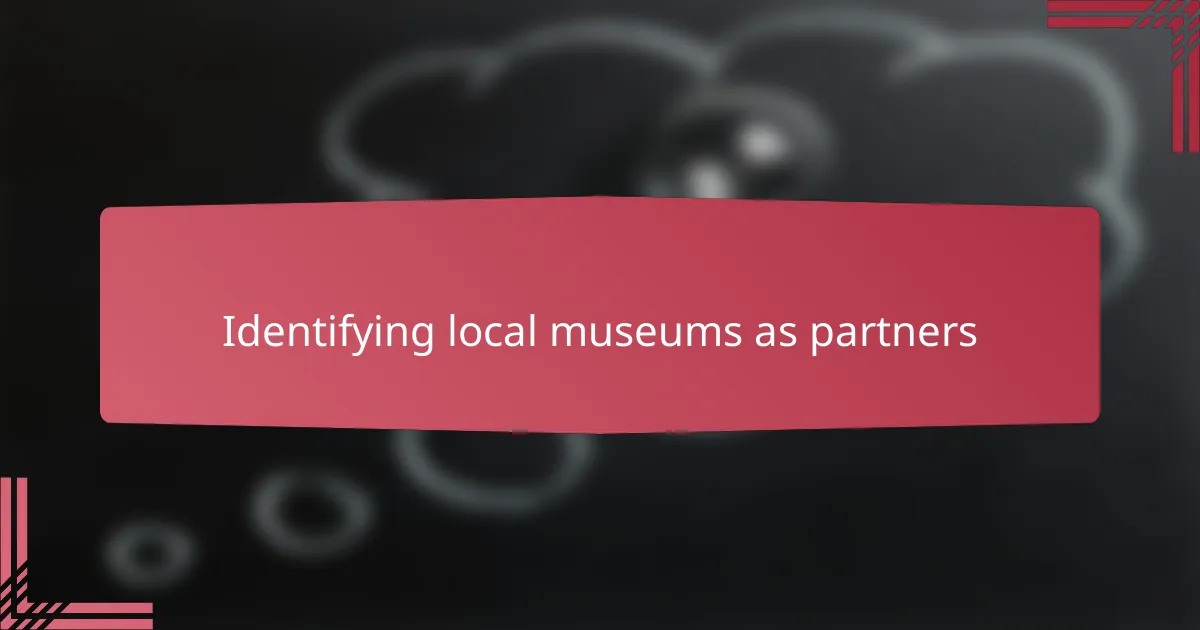
Identifying local museums as partners
When I started looking for local museums to partner with, I asked myself: which places hold stories that truly resonate with my students’ backgrounds and struggles? I knew it wasn’t just about finding any museum nearby, but about discovering spaces that reflect the voices we want to amplify in the classroom. This focus made my search more intentional and rewarding.
I found that identifying these museums often involved a bit of digging—checking their current exhibits, mission statements, and community programs. Sometimes, a small, lesser-known museum held richer resources than a big, well-known one. It reminded me that quality and relevancy mattered far more than size or fame.
Have you ever felt uncertain about whether a museum’s resources could truly support your activist teaching goals? I definitely did at first. But reaching out and visiting helped me build a clearer picture. I realized museums aren’t just repositories of artifacts—they’re potential collaborators who understand the power of storytelling in education.
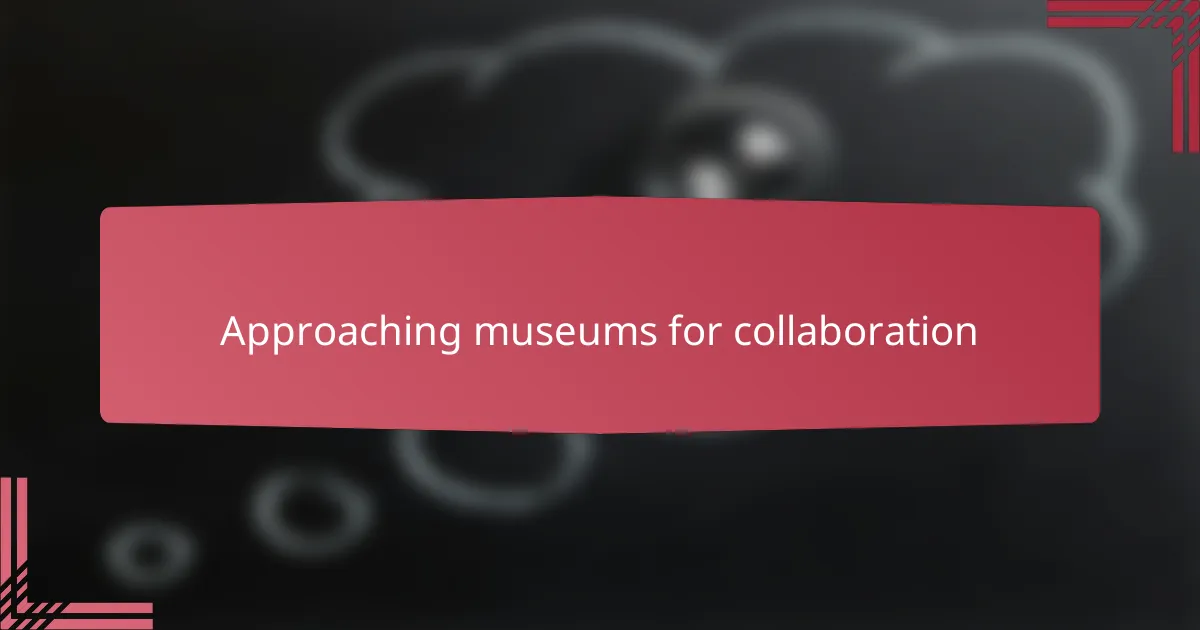
Approaching museums for collaboration
Approaching museums for collaboration felt a bit daunting at first—how do you even start that conversation? I found that beginning with a simple, genuine email explaining my classroom goals opened doors more smoothly than I expected. It was important for me to show that this wasn’t just a one-off ask but a chance to build an ongoing partnership that benefits both students and the museum.
I remember the relief when a curator responded warmly and offered to meet in person. That face-to-face connection made all the difference, allowing me to share my vision and hear theirs. Have you noticed how collaboration thrives on these small, authentic moments? They turn a transactional exchange into a shared commitment, which I believe is the heart of meaningful educational partnerships.
One thing I learned quickly was to be clear about what I needed, yet flexible enough to embrace the museum’s expertise and offerings. Sometimes I wanted specific resources, but they suggested alternative approaches that enriched my lessons even more. Isn’t that the beauty of collaboration—discovering new possibilities together?
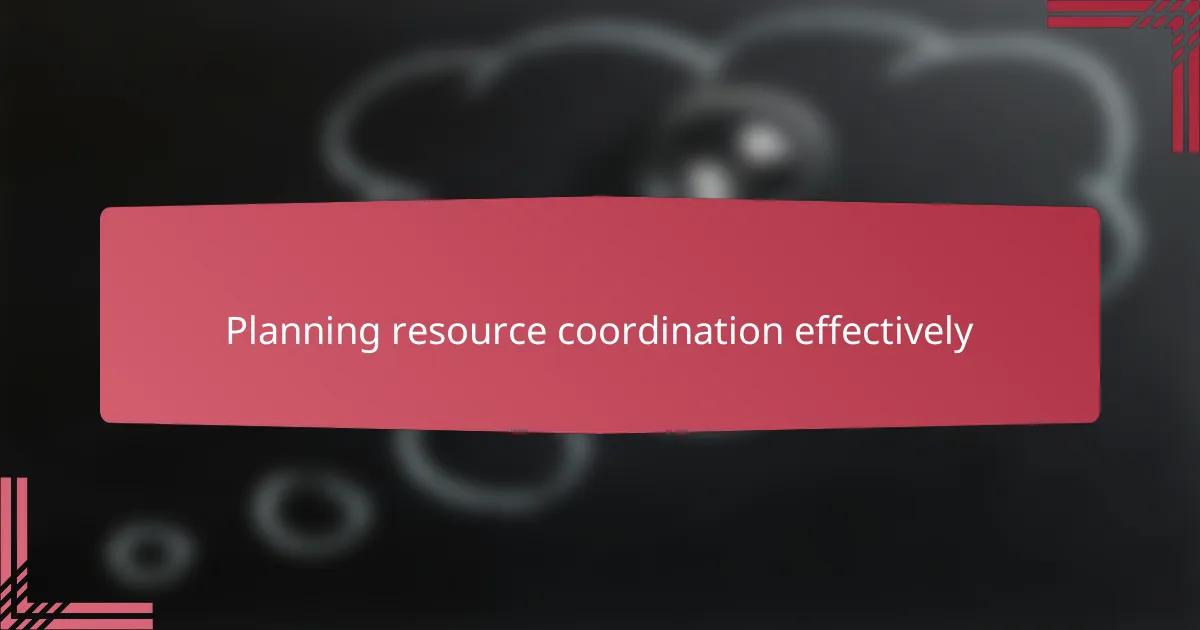
Planning resource coordination effectively
Effective planning became my anchor when coordinating resources with local museums. I started by mapping out clear goals—what themes did I want my students to explore, and which museum assets aligned best? This step saved me from feeling overwhelmed and helped focus my conversations with museum staff.
I also found that timing matters more than I expected. Reaching out well in advance gave everyone room to prepare thoughtfully, avoiding last-minute scrambles that add stress rather than spark creativity. Have you ever rushed a resource request only to miss out on deeper collaboration? I certainly have, and it taught me to prioritize patience and pacing.
Another trick I discovered was setting up a shared communication plan—emails for updates, occasional meetings for brainstorming, and quick check-ins to troubleshoot. This steady rhythm kept us on the same page and made adjustments feel natural rather than forced. After all, doesn’t smooth teamwork make the whole experience more rewarding? Based on my experience, it absolutely does.
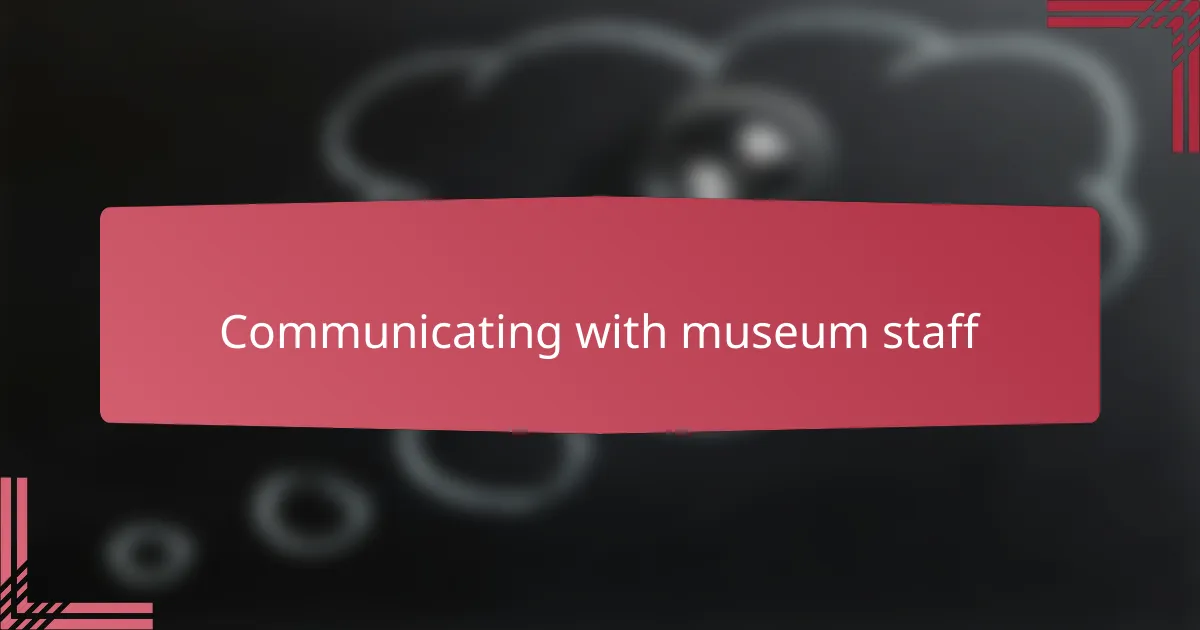
Communicating with museum staff
When I first reached out to museum staff, I quickly realized that clear and respectful communication was everything. I made it a point to listen carefully to their perspectives—to understand not just what resources they had, but how they saw their role in supporting education. Have you ever felt that hesitation in starting a conversation with experts? For me, it was about striking the right balance between expressing my needs and valuing their expertise.
I found that patience played a huge role, too. Sometimes replies took longer than I hoped, and I reminded myself that museum staff often juggle many responsibilities. Instead of pushing, I learned to send gentle follow-ups and keep the dialogue positive. This approach helped build trust and showed that I respected their time and commitments.
One moment that stands out was during a phone call when a staff member shared stories behind an exhibit that weren’t available online. That conversation gave me insights I never expected, deepening my understanding and excitement for the collaboration. Have you noticed how those personal connections can transform a simple transaction into a shared mission? It certainly did for me.
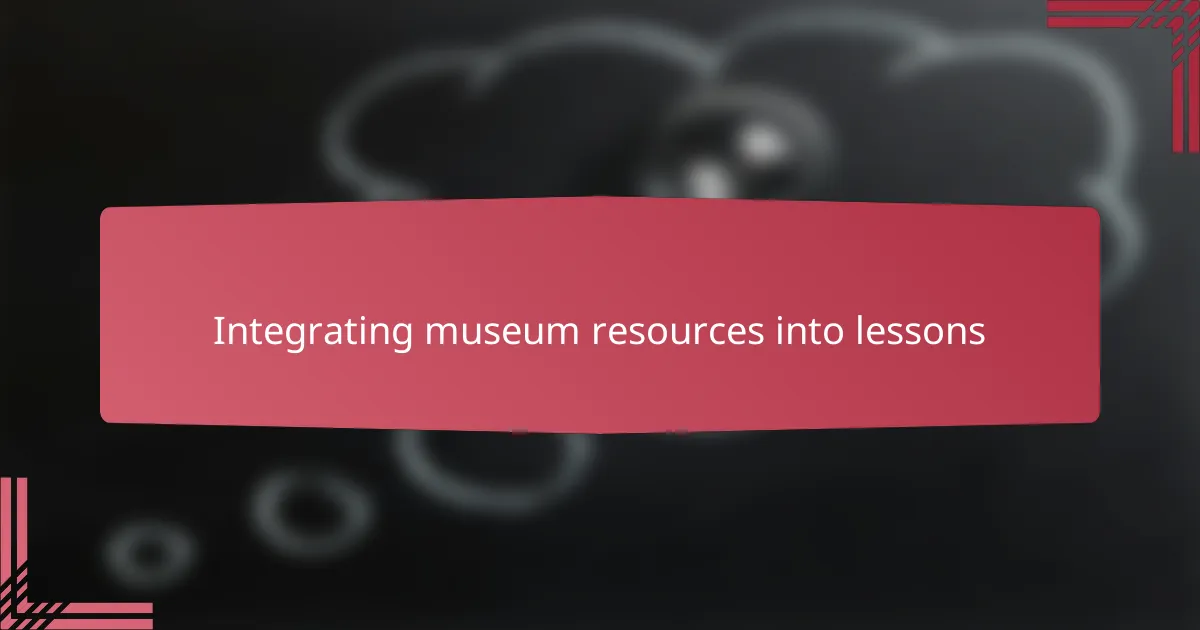
Integrating museum resources into lessons
Integrating museum resources into lessons changed how I think about classroom engagement. Instead of just reading about history or social issues, my students could see artifacts and hear stories rooted in our community. Have you ever seen a student’s eyes light up when something abstract suddenly feels real? That moment convinced me these resources offer an emotional depth textbooks often miss.
I remember designing a lesson around a civil rights exhibit and using museum photos and testimonies to spark discussion. It wasn’t just about facts anymore—it became a shared experience that invited empathy and critical thinking. When museum materials align closely with lesson goals, they don’t just supplement learning; they transform it into something active and meaningful.
One thing I learned is the importance of flexibility. Sometimes the museum’s collection steered the direction of my lesson in surprising and richer ways. Instead of forcing a specific topic, I let the resources guide the conversation, which opened doors to viewpoints I hadn’t anticipated. Isn’t that what makes teaching with these partnerships so dynamic and rewarding?
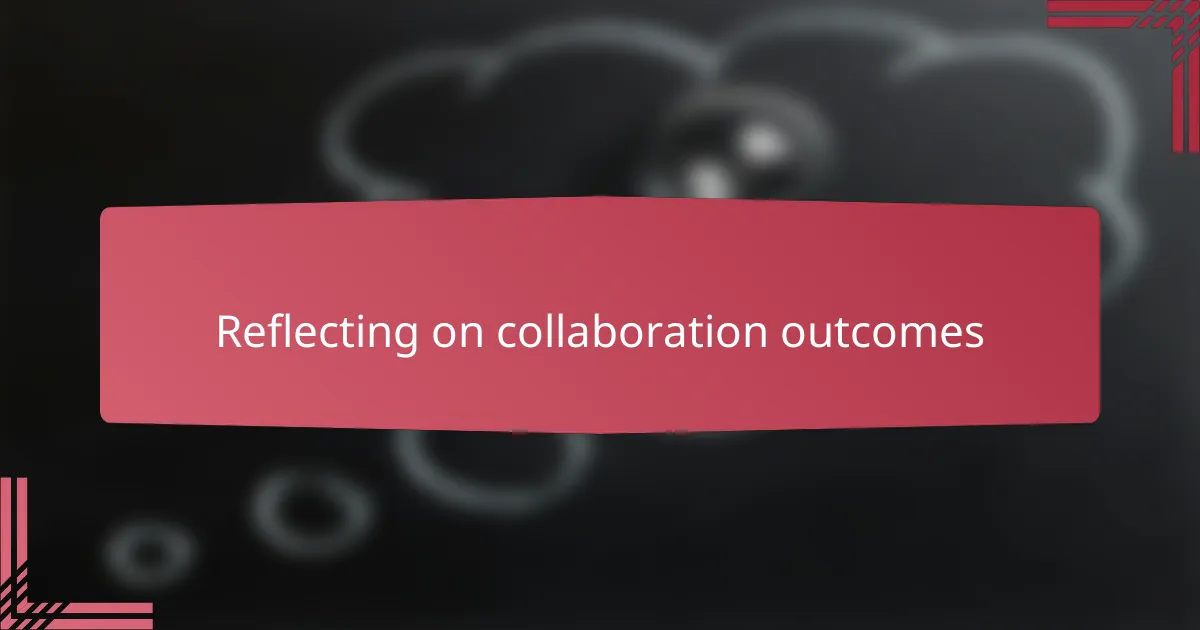
Reflecting on collaboration outcomes
Looking back on the outcomes of my collaboration with local museums, I realize how much these partnerships exceeded my expectations. The resources didn’t just fill gaps in content; they sparked deeper discussions and emotional connections among my students. Have you ever noticed how a firsthand account or artifact can suddenly shift a classroom dynamic? That’s exactly what happened here.
One particular moment stands out—a student who had been disengaged suddenly contributed a powerful insight after interacting with a museum piece. It was a reminder that meaningful collaboration isn’t just about access to materials, but about opening doors to new ways of seeing and thinking. Would this kind of impact have been possible without the museum’s involvement? I doubt it.
Of course, not every outcome was perfect. Some logistical hiccups taught me valuable lessons about communication and expectation-setting. But even those challenges highlighted the importance of patience and flexibility. Reflecting now, I see these experiences as stepping stones toward stronger, more responsive partnerships in the future. Isn’t growth often found in navigating the bumps along the way?